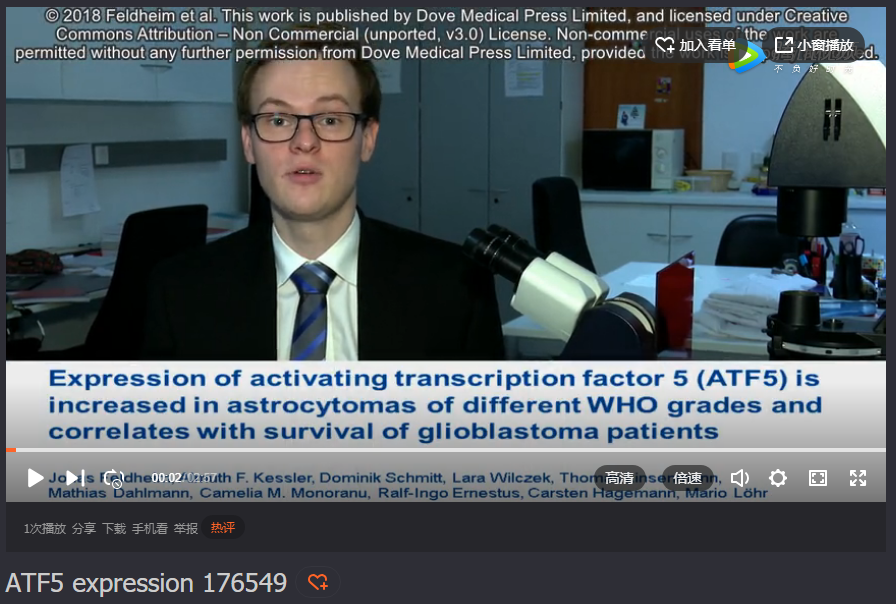9 0 5 7 8
论文已发表
注册即可获取德孚的最新动态
IF 收录期刊
- 2.6 Breast Cancer (Dove Med Press)
- 3.9 Clin Epidemiol
- 3.3 Cancer Manag Res
- 3.9 Infect Drug Resist
- 3.6 Clin Interv Aging
- 4.8 Drug Des Dev Ther
- 2.8 Int J Chronic Obstr
- 8.0 Int J Nanomed
- 2.3 Int J Women's Health
- 3.2 Neuropsych Dis Treat
- 4.0 OncoTargets Ther
- 2.2 Patient Prefer Adher
- 2.8 Ther Clin Risk Manag
- 2.7 J Pain Res
- 3.3 Diabet Metab Synd Ob
- 4.3 Psychol Res Behav Ma
- 3.4 Nat Sci Sleep
- 1.9 Pharmgenomics Pers Med
- 3.5 Risk Manag Healthc Policy
- 4.5 J Inflamm Res
- 2.3 Int J Gen Med
- 4.1 J Hepatocell Carcinoma
- 3.2 J Asthma Allergy
- 2.3 Clin Cosmet Investig Dermatol
- 3.3 J Multidiscip Healthc

Expression of activating transcription factor 5 (ATF5) is increased in astrocytomas of different WHO grades and correlates with survival of glioblastoma patients
Authors Feldheim J, Kessler AF, Schmitt D, Wilczek L, Linsenmann T, Dahlmann M, Monoranu CM, Ernestus RI, Hagemann C, Löhr M
Received 8 June 2018
Accepted for publication 18 October 2018
Published 4 December 2018 Volume 2018:11 Pages 8673—8684
DOI https://doi.org/10.2147/OTT.S176549
Checked for plagiarism Yes
Review by Single-blind
Peer reviewers approved by Dr Cristina Weinberg
Peer reviewer comments 2
Editor who approved publication: Dr Arseniy Yuzhalin
Background: ATF5 suppresses differentiation of
neuroprogenitor cells and is overexpressed in glioblastoma (GBM). A reduction
of its expression leads to apoptotic GBM cell death. Data on ATF5 expression in
astrocytoma WHO grade II (low-grade astrocytoma [LGA]) are scarce and lacking
on recurrent GBM.
Patients and methods: ATF5 mRNA was extracted from frozen samples of patients’ GBM
(n=79), LGA (n=40), and normal brain (NB, n=10), quantified by duplex qPCR and
correlated with retrospectively collected clinical data. ATF5 protein
expression was evaluated by measuring staining intensity on
immunohistochemistry.
Results: ATF5
mRNA was overexpressed in LGA (sevenfold, P <0.001) and GBM
(tenfold, P <0.001)
compared to NB, which was confirmed on protein level. Although ATF5 mRNA
expression in GBM showed a considerable fluctuation range, groups of varying
biological behavior, that is, local/multifocal growth or primary tumor/relapse
and the tumor localization at diagnosis, were not significantly different. ATF5
mRNA correlated with the patients’ age (r =0.339, P =0.028) and inversely with Ki67-staining (r =-0.421, P =0.007). GBM
patients were allocated to a low and a high ATF5 expression group by the median
ATF5 overexpression compared to NB. Kaplan–Meier analysis and Cox regression
indicated that ATF5 mRNA expression significantly correlated with short-term
survival (t <12
months, median survival 18 vs 13 months, P =0.022, HR 2.827)
and progression-free survival (PFS) (12 vs 6 months, P =0.024). This
advantage vanished after 24 months (P =0.084).
Conclusion: ATF5
mRNA expression could be identified as an additional, though not independent
factor correlating with overall survival and PFS. Since its inhibition might
lead to the selective death of glioma cells, it might serve as a potential
ubiquitous therapeutic target in astrocytic tumors.
Keywords: glioblastoma
multiforme, recurrence, growth pattern, protein and mRNA expression
摘要视频链接:ATF5 expression
in astrocytic tumors
